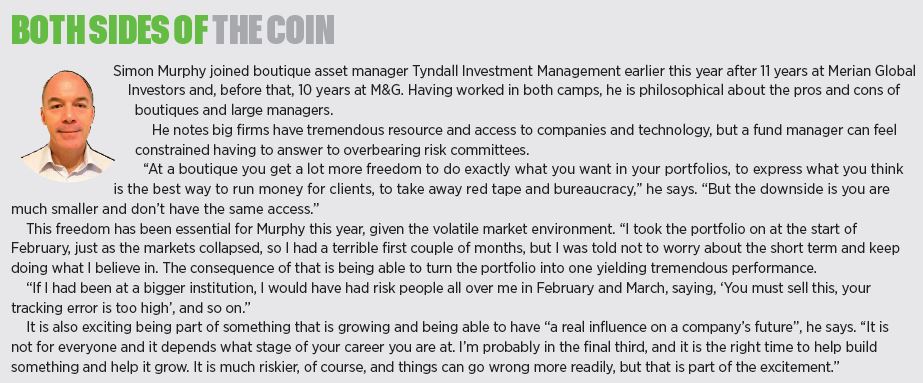Mass adoption of digital communication and home working due to the Covid-19 pandemic has levelled the playing field between large and small asset managers. The shift to a virtual environment for everything from pitches and catch-ups to events and media briefings has saved fund managers and sales teams both time and budget when distributing products – and enabled the little guy to stand toe to toe with the big boys.
In the past year, several fund managers have moved to boutiques. Nick Clay and his team left BNY Mellon Investment Management for RWC Partners, while Fidelity’s James Bateman and heavyweight European managers from Neptune and Jupiter, Rob Burnett and Alexander Darwall, set up their own outfits. These moves highlight the lure of boutiques for managers wishing to spread their wings, unencumbered by shareholders or complex corporate structures.
Being unleashed at a boutique can also aid performance, it seems. Cass Business School research, published in April, found risk-adjusted returns tended to be higher for boutiques than non-boutiques. This was particularly the case in European mid and small caps, and global emerging market equities, but less so in European and global large cap.
See also: Are boutiques really better placed to navigate volatility?
Portfolio Adviser spoke with three boutique asset manager chief executives to find out how the pandemic has affected their business model, interaction with clients and staff, technology spend and how they have managed to remain competitive
How have the business models of boutique managers been affected by the Covid-19 pandemic?
Tony Dalwood, chief executive, Gresham House: “Different businesses have had to adapt in different ways. One advantage of being a smaller business is our ability to innovate more quickly and adopt new technology. We have tried to keep processes simple and the time taken from decision-making through to action is very swift. Even before the pandemic, we had digitised our processes. Our infrastructure is all cloud-based, so it makes no difference where staff are located – they have the ability to use the same systems and tools to do their jobs wherever they are. This has been consistently applied in all our offices.”
Doug Stewart, chief executive, BennBridge: “Most firms were already increasing flexibility before Covid-19 in areas such as hot-desking, open-plan and shared spaces, flexible working hours and remote working. The pandemic has accelerated these trends for most businesses, particularly those expanding with talent spread over multiple regions.
“We also benefit from the agility and adaptability that comes with being a boutique. For example, our different teams can implement bespoke solutions based on their location and circumstances without being encumbered by the structure of a large corporation.
“Our size and structure have allowed us to adapt quickly to support our people with flexible working arrangements, which will remain permanent regardless of when restrictions are reduced.”
Has interaction with clients and internal staff been affected?
Dalwood: “We encourage staff to ‘over-communicate’ with their colleagues and clients to make sure nothing is taken for granted. We also introduced a weekly company-wide video call to remind everyone they are still part of a larger family with clear short- and long-term goals, even while working from home.”
Ian Macoun, founder and managing partner, Pinnacle Investment Management: “We have seen an increase in client meeting numbers as travel time to and from meetings has been cut to zero. Clients have also had more time to participate. Meeting clients in person will always remain an important part of our distribution efforts, but there is no doubt an increased level of video conferencing and digital communications will be a legacy of Covid-19.”
Speaking of increased technology usage, in many cases larger groups have deeper pockets to spend on tech. Can boutiques keep up?
Dalwood: “It is the opposite. Innovation is best facilitated by small groups of people not weighed down by legacy systems. For larger companies, the time to innovate is longer and generating a return on this investment in a short space of time is more difficult. Technology, and especially its reduction in cost, has been a great leveller for all businesses and is particularly important for a growing business like ours.”
Macoun: “While the bigger financial corporations usually have access to large scale technology departments, smaller groups and boutiques have flatter structures. This means they are more nimble and able to quickly find solutions and adapt to challenges.”
With increased spending on tech, is the office now largely redundant?
Macoun: “We do not envisage the end of the office, but it is very likely going to change. This period has proved remote working can occur seamlessly. If businesses’ efficiencies can be gained from more employees choosing to work from home, this is an opportunity we will exploit. However, it is too early to predict at this stage the full extent of the permanent and enduring business model changes resulting from Covid-19.”
Dalwood: “The pandemic has certainly shown a flexible approach to working functions, but equally, we believe there is still a place for the physical office. We put a lot of emphasis on culture and much of this comes from the interaction an office environment provides. Each member of our team have their own areas of speciality, and the office environment gives the team the opportunity to exchange ideas, both formally and informally.”
Stewart: “It is important for us boutiques, as well as larger firms, to recognise the remote working environment looks different across geographies. It is not a one-size-fits-all approach for either small or large groups. The real issue is maintaining morale, culture and engagement, with teams and clients alike.”

Can boutiques compete in a market increasingly dominated by passives?
Macoun: “The rise of passive index investing has been a headwind for many active boutique managers in recent years, but the Covid-19 volatility has renewed focus on capital preservation and performance, resulting in increased support for active investment managers.”
Finally, what are the opportunities for boutique asset managers?
Stewart: “Many boutiques are in growth mode. Using the flexibility and balance of our business model will allow us to attract talent. There is no doubt 2021 will be a year of transition, but the increasing demand for proven targeted solutions and the flexibility it affords to investment managers gives us the opportunity to remain competitive.”
Dalwood: “Investors are increasingly looking to boutiques to provide a point of difference and diversification for their portfolios. To differentiate ourselves, we have placed sustainability at our core, and our investment platforms, such as forestry and renewables, naturally lend themselves to the increasing focus of governments and investors on sustainability goals.
“Our commitment to the principles of ESG is central to expanding the business. As the recent pace of change increases the ability of boutiques to prove their agility and adaptability over the short and long term, 2021 presents myriad opportunities for boutiques.”
Macoun: “We see exciting opportunities for boutique investment managers in alternative asset classes such as emerging markets, real assets and agriculture, as clients who are uncertain about the future look for uncorrelated sources of alpha in order to build more robust portfolios.”








